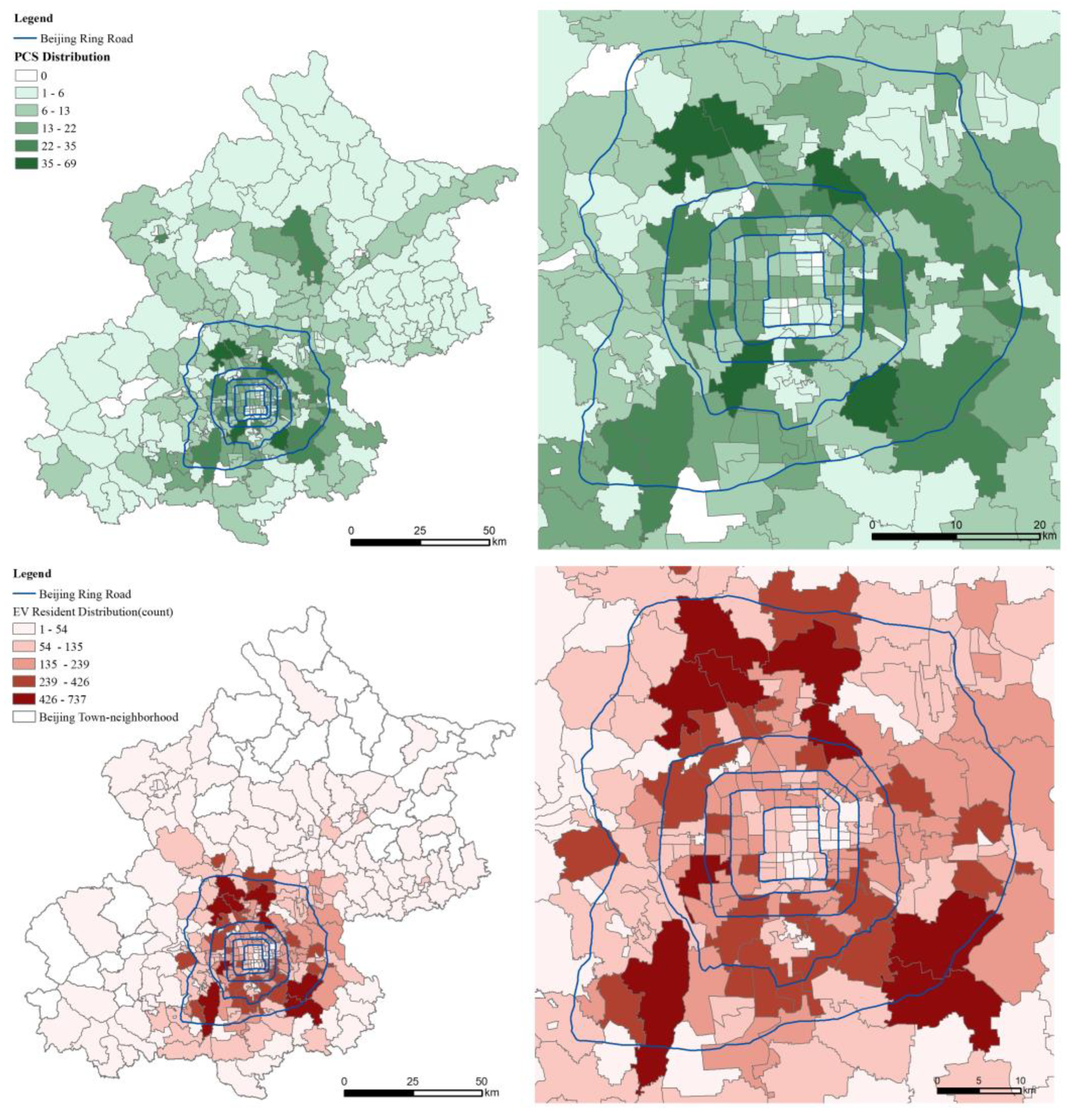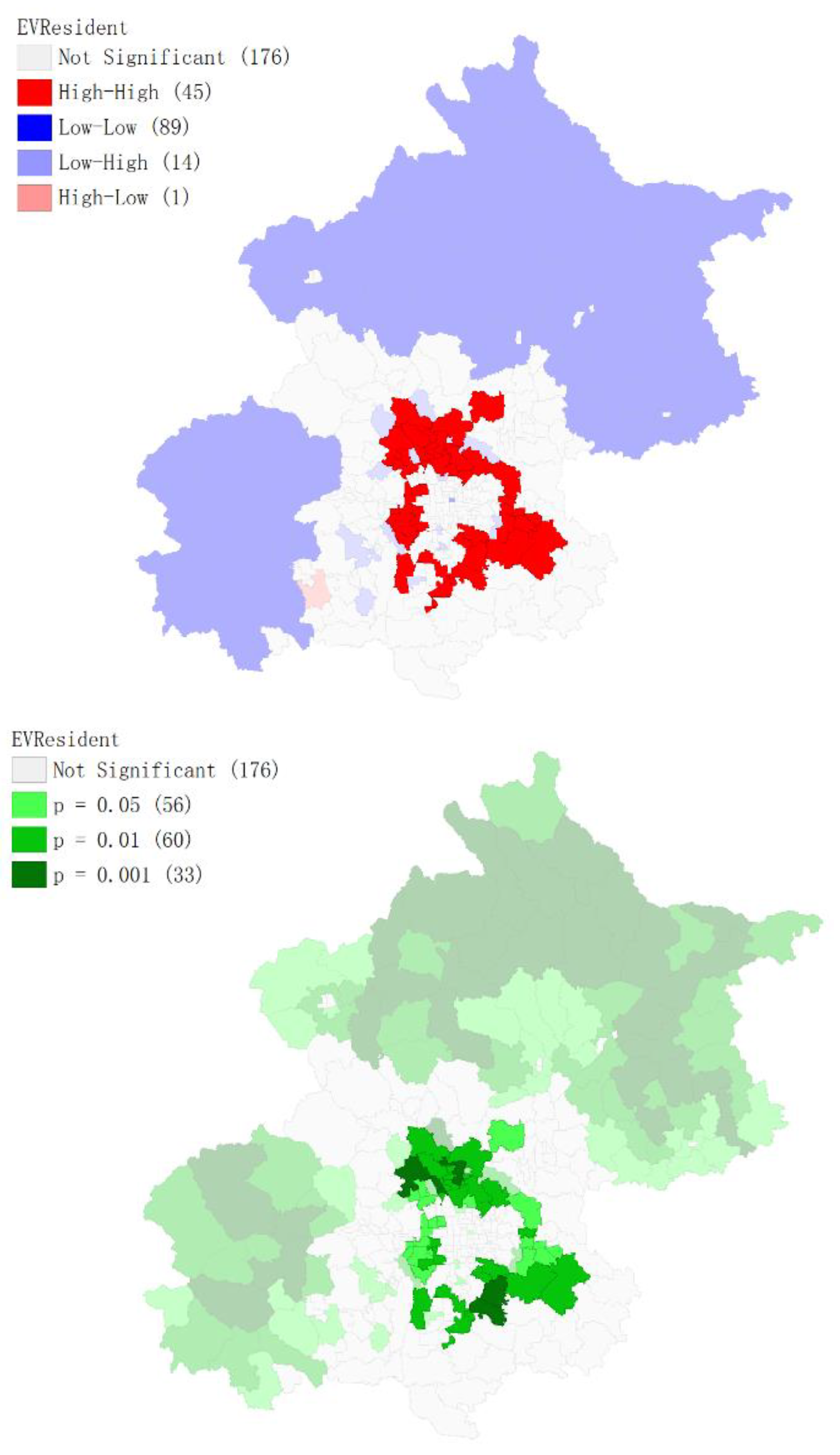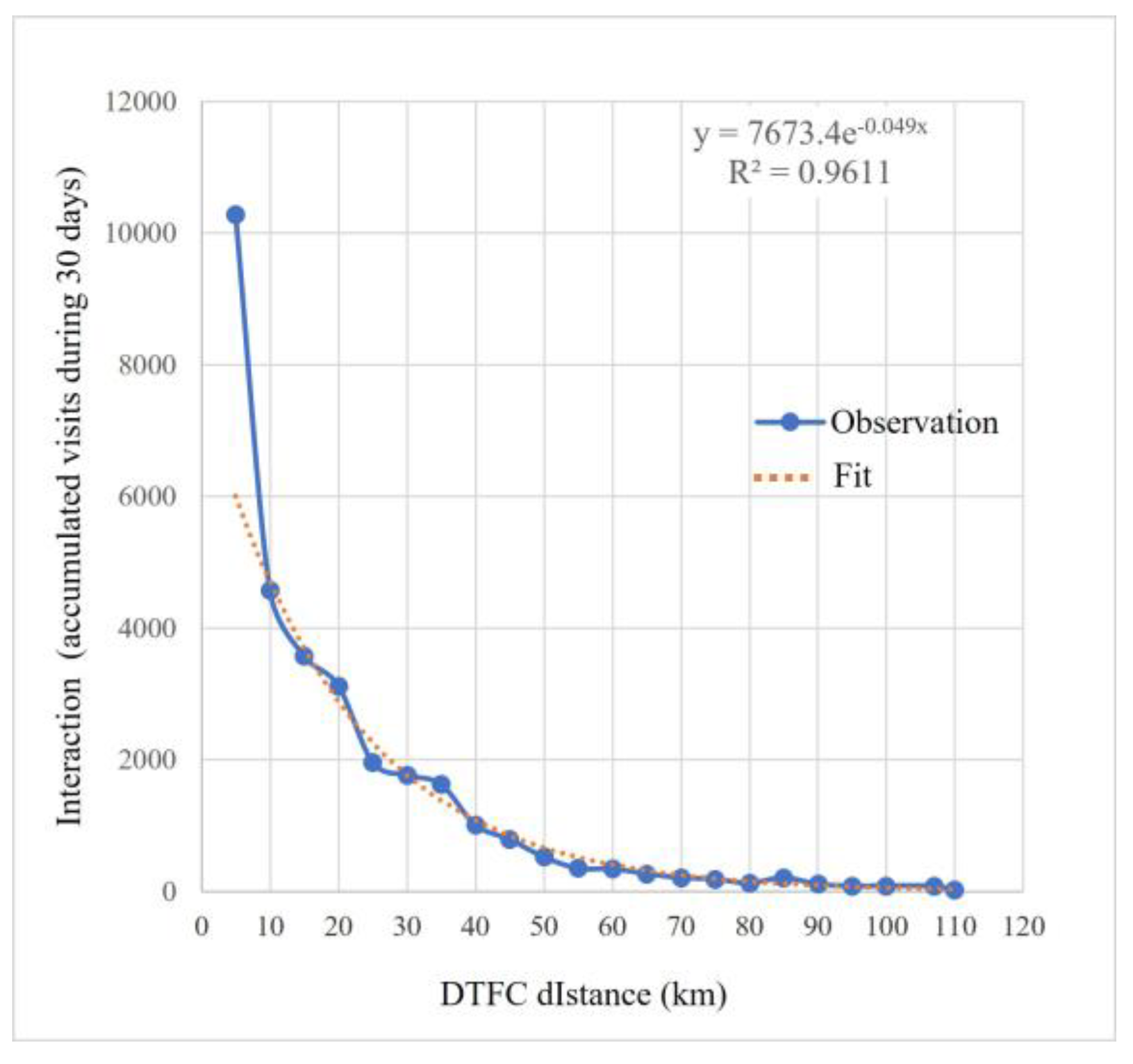Are Electric Vehicles Reshaping the City? An Investigation of the Clustering of Electric Vehicle Owners’ Dwellings and Their Interaction with Urban Spaces
Abstract
1. Introduction
2. Research Area and Data Preprocessing
2.1. Research Area
2.2. LBS Data
2.3. Land Use Data of Residential Areas and Employment
3. Method
3.1. Spatial Autocorrelation
- (1)
- Large positive values (close to 1) indicate that there is strong (positive) autocorrelation (i.e., similar values tend to cluster together);
- (2)
- Large negative values (close to −1) indicate that there is strong negative autocorrelation (i.e., areas with similar values of a variable tend to repel each other; dispersion);
- (3)
- Values around 0 indicate that there is no spatial autocorrelation (random pattern).
3.2. Distance Decay Modeling
3.3. Spatial Aggregation
4. Results and Discussion
4.1. Distribution of EV Residential Areas
4.2. Spatial Interaction Characteristics
4.3. Visualization of DTFC Flow Patterns
5. Conclusions
Author Contributions
Funding
Data Availability Statement
Acknowledgments
Conflicts of Interest
References
- IEA. Global EV Outlook. 2019. Available online: https://www.iea.org/reports/global-ev-outlook-2019 (accessed on 31 May 2019).
- Stanford Precourt Institute for Energy. EV50: Enabling Beyond 50 Percent Adoption of Electric Vehicles, EV50 Program White Paper, Stanford University. 2019. Available online: https://stanford.app.box.com/s/fn9whj74lpng4bi0tv0ifh66mwh5tnad (accessed on 31 October 2019).
- Liang, X.; Zhang, S.; Wu, Y.; Xing, J.; He, X.; Zhang, K.M.; Wang, S.; Hao, J. Air quality and health benefits from fleet electrification in China. Nat. Sustain. 2019, 2, 962–971. [Google Scholar] [CrossRef]
- Ke, W.; Zhang, S.; He, X.; Wu, Y.; Hao, J. Well-to-wheels energy consumption and emissions of electric vehicles: Mid-term implications from real-world features and air pollution control progress. Appl. Energy 2017, 188, 367–377. [Google Scholar] [CrossRef]
- Romero Lankao, P.; Wilson, A.; Sperling, J.; Miller, C.; Zimny-Schmitt, D.; Bettencourt, L.; Wood, E.; Young, S.; Muratori, M.; Arent, D.; et al. Urban Electrification: Knowledge Pathway Toward an Integrated Research and Development Agenda. In Mansueto Institute for Urban. Innovation Research Paper; The University of Chicago: Chicago, IL, USA, 2019. [Google Scholar] [CrossRef]
- Ip, A.; Fong, S.; Liu, E. Optimization for allocating BEV recharging stations in urban areas by using hierarchical clustering. In Proceedings of the IEEE 6th International Conference on Advanced Information Management and Service, Seoul, Korea, 30 November–2 December 2010; pp. 460–465. [Google Scholar]
- Neubauer, J.; Wood, E. The impact of range anxiety and home, workplace, and public charging infrastructure on simulated battery electric vehicle lifetime utility. J. Power Source 2014, 257, 12–20. [Google Scholar] [CrossRef]
- Newman, D.; Wells, P.; Donovan, C.; Nieuwenhuis, P.; Davies, H. Urban, sub-urban or rural: Where is the best place for electric vehicles? Int. J. Automot. Technol. Manag. 2014, 14, 306–323. [Google Scholar] [CrossRef]
- Ioannides, D.; Wall-Reinius, S. Sustainable Mobility in the Periphery: Are Electric Vehicles the Answer? Review of International Literature on Electric Vehicles and Ideas for Further Research; European Tourism Research Institute: Mittuniversitetet, Sweden, 2015; Available online: http://worldcat.org/isbn/9789188025296 (accessed on 31 May 2015).
- Kester, J.; Sovacool, B.K.; Noel, L.; de Rubens, G.Z. Rethinking the spatiality of Nordic electric vehicles and their popularity in urban environments: Moving beyond the city? J. Transp. Geogr. 2020, 82, 102557. [Google Scholar] [CrossRef]
- Plötz, P.; Schneider, U.; Globisch, J.; Dütschke, E. Who will buy electric vehicles? Identifying early adopters in Germany. Transp. Res. Part A Policy Pract. 2014, 67, 96–109. [Google Scholar] [CrossRef]
- Li, W.B.; Long, R.Y.; Chen, H.; Geng, J.C. A review of factors influencing consumer intentions to adopt battery electric vehicles. Renew. Sustain. Energy Rev. 2017, 78, 318–328. [Google Scholar] [CrossRef]
- Fornahl, D.; Wernern, N. New Electric Mobility in Fleets in the Rural Area of Bremen/Oldenburg; E-Mobility in Europe, Green Energy and Technology; Springer: Cham, Switzerland, 2015; pp. 237–251. [Google Scholar] [CrossRef]
- Zhang, R.; Zhang, J.; Long, Y.; Wu, W.; Liu, J.; Jiang, Y. Long-term implications of electric vehicle penetration in urban decarbonization scenarios: An integrated land use–transport–energy model. Sustain. Cities Soc. 2021, 68, 102800. [Google Scholar] [CrossRef]
- Tu, W.; Santi, P.; Zhao, T.H.; He, X.Y.; Li, Q.Q.; Dong, L.; Wallington, T.J.; Ratti, C. Acceptability, energy consumption, and costs of electric vehicle for ride-hailing drivers in Beijing. Appl. Energy 2019, 250, 147–160. [Google Scholar] [CrossRef]
- Guo, F.; Yang, J.; Lu, J. The battery charging station location problem: Impact of users’ range anxiety and distance convenience. Transp. Res. Part E Logist. Transp. Rev. 2018, 114, 1–18. [Google Scholar] [CrossRef]
- Azadfar, E.; Sreeram, V.; Harries, D. The investigation of the major factors influencing plug-in electric vehicle driving patterns and charging behaviour. Renew. Sustain. Energy Rev. 2015, 42, 1065–1076. [Google Scholar] [CrossRef]
- Labeye, E.; Hugot, M.; Brusque, C.; Regan, M.A. The electric vehicle: A new driving experience involving specific skills and rules. Transp. Res. Part F Traffic Psychol. Behav. 2016, 37, 27–40. [Google Scholar] [CrossRef]
- Langbroek, J.H.; Franklin, J.P.; Susilo, Y.O. Electric vehicle users and their travel patterns in Greater Stockholm. Transp. Res. Part D Transp. Environ. 2017, 52, 98–111. [Google Scholar] [CrossRef]
- Yang, Y.; Yao, E.; Yang, Z.; Zhang, R. Modeling the charging and route choice behavior of BEV drivers. Transp. Res. Part C Emerg. Technol. 2016, 65, 190–204. [Google Scholar] [CrossRef]
- Schmidt, M.; Staudt, P.; Weinhardt, C. Evaluating the importance and impact of user behavior on public destination charging of electric vehicles. Appl. Energy 2020, 258, 114061. [Google Scholar] [CrossRef]
- Luo, L.; Gu, W.; Zhou, S.; Huang, H.; Gao, S.; Han, J.; Wu, Z.; Dou, X. Optimal planning of electric vehicle charging stations comprising multi-types of charging facilities. Appl. Energy 2018, 226, 1087–1099. [Google Scholar] [CrossRef]
- Namdeo, A.; Tiwary, A.; Dziurla, R. Spatial planning of public charging points using multi-dimensional analysis of early adopters of electric vehicles for a city region. Technol. Forecast. Soc. Chang. 2014, 89, 188–200. [Google Scholar] [CrossRef]
- De Gennaro, M.; Paffumi, E.; Martini, G. Customer-driven design of the recharge infrastructure and Vehicle-to-Grid in urban areas: A large-scale application for electric vehicles deployment. Energy 2015, 82, 294–311. [Google Scholar] [CrossRef]
- Csiszár, C.; Csonka, B.; Földes, D.; Wirth, E.; Lovas, T. Urban public charging station locating method for electric vehicles based on land use approach. J. Transp. Geogr. 2019, 74, 173–180. [Google Scholar] [CrossRef]
- Funke, S.Á.; Sprei, F.; Gnann, T.; Plötz, P. How much charging infrastructure do electric vehicles need? A review of the evidence and international comparison. Transp. Res. Part D Transp. Environ. 2019, 77, 224–242. [Google Scholar] [CrossRef]
- Baouche, F.; Billot, R.; Trigui, R.; Faouzi, N.E. Efficient allocation of electric vehicles charging stations: Optimization model and application to a dense urban network. IEEE Intell. Transp. Syst. Mag. 2014, 6, 33–43. [Google Scholar] [CrossRef]
- Hardman, S.; Shiu, E.; Wilckens, R.S. Comparing high-end and low-end early adopters of battery electric vehicles. Transp. Res. Part A Policy Pract. 2016, 88, 40–57. [Google Scholar] [CrossRef]
- Helmus, J.R.; Lees, M.H.; Hoed, R. A data driven typology of electric vehicle user types and charging sessions. Transp. Res. Part C Emerg. Technol. 2020, 115, 102637. [Google Scholar] [CrossRef]
- Lu, Y.M.; Liu, Y. Pervasive location acquisition technologies: Opportunities and challenges for geospatial studies. Comput. Environ. Urban Syst. 2012, 36, 105–108. [Google Scholar] [CrossRef]
- Ganapati, S. Mobile Location-Based Service (LBS) Apps for the Public Sector: Prospects and Challenges. In Routledge Handbook on Information Technology in Government; Routledge: New York, NY, USA, 2017; pp. 128–143. [Google Scholar] [CrossRef]
- Zhang, P.; Zhou, J.; Zhang, T. Quantifying and visualizing jobs-housing balance with big data: A case study of Shanghai. Cities 2017, 66, 10–22. [Google Scholar] [CrossRef]
- Qi, G.; Li, X.; Li, S.; Pan, G.; Wang, Z.; Zhang, D. Measuring social functions of city regions from large-scale taxi behaviors. In Proceedings of the IEEE International Conference on Pervasive Computing and Communications Workshops, Seattle, WA, USA, 21–25 March 2011; pp. 384–388. [Google Scholar] [CrossRef]
- Zhi, Y.; Li, H.; Wang, D.; Deng, M.; Wang, S.; Gao, J.; Duan, Z.; Liu, Y. Latent spatio-temporal activity structures: A new approach to inferring intra-urban functional regions via social media check-in data. Geo Spat. Inf. Sci. 2016, 19, 94–105. [Google Scholar] [CrossRef]
- Khan, N.U.; Wan, W.; Yu, S. Location-based social network’s data analysis and spatio-temporal modeling for the mega city of Shanghai, China. ISPRS Int. J. Geo Inf. 2020, 9, 76. [Google Scholar] [CrossRef]
- Gong, L.S.; Jin, M.H.; Liu, Q.; Gong, Y.; Liu, Y. Identifying Urban Residents’ Activity Space at Multiple Geographic Scales Using Mobile Phone Data. ISPRS Int. J. Geo Inf. 2020, 9, 241. [Google Scholar] [CrossRef]
- Yuan, J.; Zheng, Y.; Xie, X. Discovering regions of different functions in a city using human mobility and POIs. In Proceedings of the 18th ACM SIGKDD international conference on Knowledge discovery and data mining, Beijing, China, 14–19 August 2012; pp. 186–194. [Google Scholar] [CrossRef]
- Liu, X.; Kang, C.; Gong, L.; Liu, Y. Incorporating spatial interaction patterns in classifying and understanding urban land use. Int. J. Geogr. Inf. Sci. 2016, 30, 334–350. [Google Scholar] [CrossRef]
- Cheng, J.; Liu, J.J.; Gao, Y. Analyzing the spatio-temporal characteristics of Beijing’s OD trip volume based on time series clustering method. J. Geo Inf. Sci. 2016, 18, 1227–1239. [Google Scholar]
- Pagany, R.; Ramirez Camargo, L.; Dorner, W. A review of spatial localization methodologies for the electric vehicle charging infrastructure. Int. J. Sustain. Transp. 2019, 13, 433–449. [Google Scholar] [CrossRef]
- Weldon, P.; Morrissey, P.; Brady, J.; O’Mahony, M. An investigation into usage patterns of electric vehicles in Ireland. Transp. Res. Part D Transp. Environ. 2016, 43, 207–225. [Google Scholar] [CrossRef]
- Pan, Y.; Tian, S.; Liu, D.; Fang, Y.; Zhu, X.; Zhang, Q.; Zheng, B.; Michalski, G.; Wang, Y. Fossil Fuel Combustion-Related Emissions Dominate Atmospheric Ammonia Sources during Severe Haze Episodes: Evidence from 15N-Stable Isotope in Size-Resolved Aerosol Ammonium. Environ. Sci. Technol. 2016, 50, 8049–8056. [Google Scholar] [CrossRef] [PubMed]
- Beijing Transport Institute. Beijing Transport Annual Report; Beijing Transport Institute: Beijing, China, 2020; Available online: http://www.bjtrc.org.cn/List/index/cid/7.html (accessed on 7 May 2021).
- Yang, J.; Yi, D.; Qiao, B.; Zhang, J. Spatio-temporal change characteristics of spatial-interaction networks: Case study within the sixth ring road of Beijing, China. ISPRS Int. J. Geo Inf. 2019, 8, 273. [Google Scholar] [CrossRef]
- Ming, Y.; Zhang, J.; Qi, J.; Liao, T.; Wang, M.; Zhang, L. Prediction and Analysis of Chengdu Housing Rent Based on XGBoost Algorithm[C]. In Proceedings of the 2020 3rd International Conference on Big Data Technologies, Qingdao, China, 18–20 September 2020; pp. 1–5. [Google Scholar] [CrossRef]
- Feng, D.; Tu, L.; Sun, Z. Research on Population Spatiotemporal Aggregation Characteristics of a Small City: A Case Study on Shehong County Based on Baidu Heat Maps. Sustainability 2019, 11, 6276. [Google Scholar] [CrossRef]
- Shen, Z.; Li, M. (Eds.) Big Data Support of Urban Planning and Management: The Experience in China; Springer: Berlin/Heidelberg, Germany, 2017. [Google Scholar] [CrossRef]
- Guo, S.H.; Yang, G.G.; Pei, T.; Ma, T.; Song, C.; Shu, H.; Du, Y.Y.; Zhou, C.H. Analysis of factors affecting urban park service area in Beijing: Perspectives from multi-source geographic data. Landsc. Urban Plan. 2019, 181, 103–117. [Google Scholar] [CrossRef]
- Phithakkitnukoon, S.; Horanont, T.; Di Lorenzo, G.; Shibasaki, R.; Ratti, C. Activity-Aware Map: Identifying Human Daily Activity Pattern Using Mobile Phone Data; International Workshop on Human Behavior Understanding; Springer: Berlin/Heidelberg, Germany, 2010; pp. 14–25. [Google Scholar]
- Tobler, W. On the first law of geography: A reply. Ann. Assoc. Am. Geogr. 2004, 94, 304–310. [Google Scholar] [CrossRef]
- Anselin, L. Local indicators of spatial association—LISA. Geogr. Anal. 1995, 27, 93–115. [Google Scholar] [CrossRef]








| Weekdays 1 | Weekends 2 | ||||||
|---|---|---|---|---|---|---|---|
| Monday | Tuesday | Wednesday | Thursday | Friday | Saturday | Sunday | |
| Count | 4048 | 4047 | 4014 | 4145 | 5097 | 6115 | 4602 |
| Mean | 1012 | 1012 | 1004 | 1036 | 1019 | 1223 | 1150 |
| Total | 21,351 | 10,717 | |||||
| Total mean | 1017 | 1191 | |||||
| Region | Residential pp (%) | High Density Areas | Employment pp (%) | High Density Areas | EV Residential(%) |
|---|---|---|---|---|---|
| Within 2nd (urban central area) | 5% | N3RR, S3RR, SIH, WAJ | 7% | CBD, ZGC, JRJ, WAJ, WKS, FTP | 4% |
| 2–3 | 9% | 11% | 9% | ||
| 3–4 | 13% | 15% | 13% | ||
| 4–5 (Urban area) | 16% | 16% | 17% | ||
| 5–6 (Suburban) | 36% | HLG, TTY, QIH, DFZ, TZNT | 30% | SHD, LGY, YIZ | 40% |
| Outside of 6th ring road | 22% | 21% | 16% | ||
| (Rural) |
Publisher’s Note: MDPI stays neutral with regard to jurisdictional claims in published maps and institutional affiliations. |
© 2021 by the authors. Licensee MDPI, Basel, Switzerland. This article is an open access article distributed under the terms and conditions of the Creative Commons Attribution (CC BY) license (https://creativecommons.org/licenses/by/4.0/).
Share and Cite
Kang, J.; Kan, C.; Lin, Z. Are Electric Vehicles Reshaping the City? An Investigation of the Clustering of Electric Vehicle Owners’ Dwellings and Their Interaction with Urban Spaces. ISPRS Int. J. Geo-Inf. 2021, 10, 320. https://doi.org/10.3390/ijgi10050320
Kang J, Kan C, Lin Z. Are Electric Vehicles Reshaping the City? An Investigation of the Clustering of Electric Vehicle Owners’ Dwellings and Their Interaction with Urban Spaces. ISPRS International Journal of Geo-Information. 2021; 10(5):320. https://doi.org/10.3390/ijgi10050320
Chicago/Turabian StyleKang, Jing, Changcheng Kan, and Zhongjie Lin. 2021. "Are Electric Vehicles Reshaping the City? An Investigation of the Clustering of Electric Vehicle Owners’ Dwellings and Their Interaction with Urban Spaces" ISPRS International Journal of Geo-Information 10, no. 5: 320. https://doi.org/10.3390/ijgi10050320
APA StyleKang, J., Kan, C., & Lin, Z. (2021). Are Electric Vehicles Reshaping the City? An Investigation of the Clustering of Electric Vehicle Owners’ Dwellings and Their Interaction with Urban Spaces. ISPRS International Journal of Geo-Information, 10(5), 320. https://doi.org/10.3390/ijgi10050320






